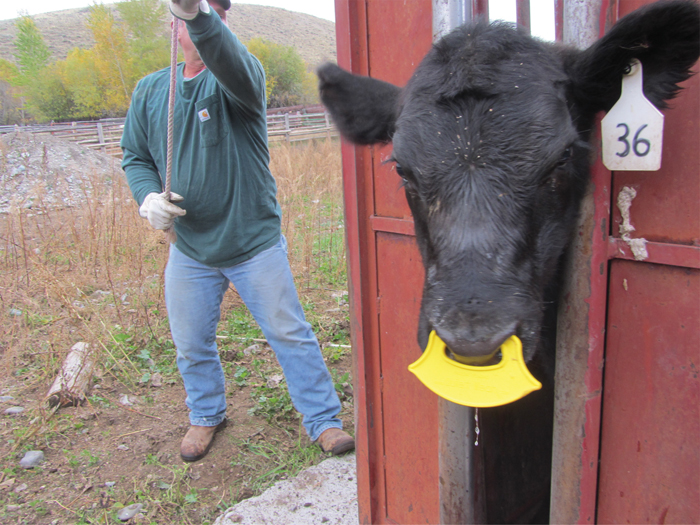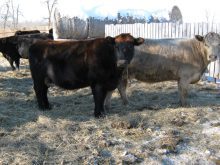Every year, weaning time is a stress on people and animal. On our ranch, we started fenceline weaning about 25 years ago — separating the cows from the calves but putting them in adjacent pens or pastures so they could still go to the fence and be next to each other. It was a little easier on them than the “cold turkey” weaning we did earlier, leaving the calves in a corral and taking their mothers to a far pasture, but they still bawled a lot and were very upset.
In the fall of 2014 we tried something different, using “nose flaps” on the calves and leaving the pairs together until the cows’ milk started drying up. We’d heard great reports about this method from ranchers who use it, and I’d talked to Joe Stookey, who invented this innovative device at the Western College of Veterinary Medicine, University of Saskatchewan, about 10 years ago. The “nose flaps” are now marketed as a product called Quiet Wean.
Read Also

Harvest wraps up and fall work begins
At the Eppich famly ranch in western Saskatchewan, the fall harvest was successful with few breakdowns, cows and calves have been sorted and a new tractor has arrived
Calves are very stressed when separated from their mothers, and stress can lead to immune suppression and vulnerability to disease, especially if the stress of weaning is coupled with bad weather and/or a long transport when newly weaned calves are sold. It always pays to try to reduce stress on calves, but this can be a challenge sometimes.
Following nature
In nature, without human intervention, calves are weaned by their mothers kicking them off before the next calf is born. The big calf follows along and stays with the cow, never losing the comfort and security of her presence. He may still try to nurse for a few days, but the cow won’t let him, and he resigns himself to weaned status.
When I talked to Joe Stookey about nose flaps, he said it all came about because of a student’s question. “One of our students asked what does the calf miss most — the milk or the mother? So we decided to find out. When we did the study and took away the milk by creating this anti-sucking device, none of the calves were upset,” Stookey said. “Then when we took away the mother a few days later they didn’t miss her either, and we realized we’d already weaned the calves. We had weaned them in the presence of the mother and that was the big difference. It was an amazing revelation about the whole weaning process.”
These small plastic flaps can be quickly and easily installed in seconds, with the calves restrained in a chute. Then the calves are returned to their mothers. The flap hangs down over the nose and mouth, preventing the calf from getting a teat into his mouth to nurse, but does not hinder eating grass or hay or drinking water.
The calf cannot nurse, but he’s not emotionally upset because he’s still with his mother. He feels secure because he has her companionship and protection during the weaning process. The cow starts to dry up, and the calf adjusts to not having milk. About five to seven days later, cows and calves can be completely separated from one another and the flaps removed from the calves, and they are not stressed.
Easy process
We ordered nose flaps for our calves last fall and put them in one week before preg-checking our cows. It was humorous to watch them afterward; they’d run to mom and try to nurse, and just stand there — and bunt the udder in frustration — and get kicked. Mom couldn’t figure out why baby wasn’t nursing, but neither of them were stressed. They kept track of each other and spent time together, but there was no desperation, no frantic pacing/bawling like what happens with other weaning methods.
By the time we took out the nose flaps a week later, when we ran the calves through the chute again for vaccinations, the cows were drying up and the calves essentially weaned. We put the calves in a new pasture and took the cows to our upper place to spend the rest of the fall on mountain pasture, and everybody was happy. It sure was easier on everyone.















